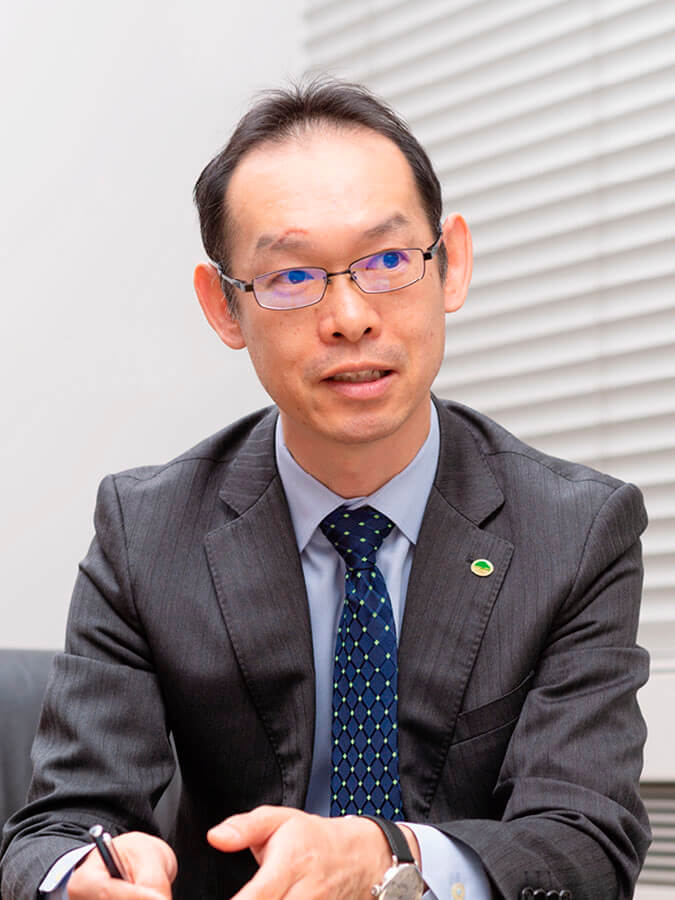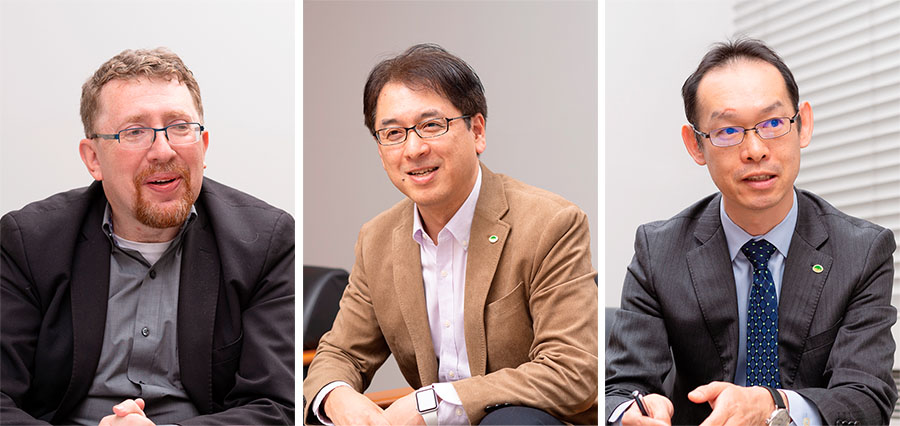Rapidly Expanding SDGs, Society 5.0, and AI Markets

Mark Minevich
Senior Fellow and Adviser of the United Nations Office for Project Services (UNOPS) and U.S. Council on Competitiveness
The principle founder of Going Global Ventures in New York, co-founder and board member of AI Pioneers Forum, Senior Fellow, and Adviser of the United Nations Office for Project Services (UNOPS) and the U.S. Council on Competitiveness, a member of the B20’s Digital Task Force and senior advisor to AI Capital Venture Fund. In the global technology market, he has been engaged in business strategy and innovation consulting for over 20 years. Mark has recently partnered and acts as independent adviser on innovation with Hitachi, Ltd. and Hitachi Systems, Ltd.
Tashiro:From about a decade ago, Hitachi has been engaging in its Social Innovation Business that seeks to use digital technology to make social infrastructure smarter and more sophisticated. While this remains its main purpose, digital technology has advanced and spread dramatically over that time, bringing major changes in the commercial environment and in conjunction with this the objectives of the business have also expanded. Along with infrastructure, the objectives now include making society smarter as a whole, including by contributing to the achievement of the United Nations Sustainable Development Goals (SDGs) and Japan's Society 5.0. One of the technologies essential to achieving this is artificial intelligence (AI). As someone familiar with business as well as the technology of AI, can you please give us your view of the current business environment and what is happening with AI?
Minevich:Global society is simultaneously facing the major challenges of climate change, hunger, and poverty that bear on the future of humanity and civilization. We are at a pivotal moment in history, and it was in recognition of this that the United Nations convened its Sustainable Development Summit in 2015. The outcome document of that summit contained the 17 goals and 169 targets that make up the SDGs.
What makes the SDGs different from past development objectives is how they are presented as business opportunities for companies. At the 2016 World Economic Forum Annual Meeting (the Davos Meeting), a team surveying global financial leaders reported that achieving the SDGs had the potential to deliver 12 trillion US dollars in economic benefits by 2030.
I see the Society 5.0 concept being promoted by Japan as having a major role to play in the advancement of the sustainable future envisaged by the SDGs. Unlike the technological focus of initiatives like Industrie 4.0, by presenting the sort of society you want to create Society 5.0 represents an opportunity for a major transformation of business and industry.
I attended the Business 20 (B20) Tokyo Summit on March 14 and 15 where one of the main items on the agenda was “Society 5.0 for SDGs.” Investment in areas relating to Society 5.0 is rapidly growing in the Japanese market. Total investment in robotics is approaching 87 billion US dollars, with the amount going into the Internet of Things (IoT) alone reaching six billion in 2019. Growth is also anticipated in key areas like healthcare, mobility, and fintech. The future progress of Society 5.0 will also bring changes to the profit structures of businesses, with the prospect of rising investment in startups with new business or service models.
2018 can be seen as the year in which AI went mainstream. Examples include the cumulative total since 2013 of venture capital investments reaching more than 5,000 AI startups, totaling nearly 19 billion US dollars. The AI market is experiencing rapid growth, with a report by CB Insights indicating about 500 investments in AI startups in the USA in 2018 alone, with a value of more than 9.3 billion US dollars.
Hitachi Research and Development of AI for a Smart Society

Takashi Tashiro
General Manager, Research & Development Division, Hitachi Systems, Ltd.
Mr. Tashiro joined Hitachi, Ltd. in 1989. After working at the Device Development Center and Hitachi Computer Products, America, he directed research on the cloud (AI, RPA), security, networks (IoT/M2M), etc. at Hitachi Systems’ Research & Development Division from 2012. Mr. Tashiro has held his current position since 2018. He holds certification as P.E.Jp in Information Engineering. He is a member of the Institution of Professional Engineers, Japan (IPEJ).
Tashiro:While, at Hitachi Systems, Ltd., we have in the past focused mainly on system integration (SI) and the maintenance and operation of information technology (IT) equipment, we are also contributing to our customers' digitalization, with recent involvement in the remote management and maintenance of photovoltaic power plants using technologies such as AI and the IoT, and also in smart agriculture and smart manufacturing. We have also worked with the Research & Development Group at Hitachi, Ltd. to develop and supply solutions such as one for the inspection and measurement of infrastructure that combines drones with AI-based image analysis. We also intend to devote more effort to AI in the future, having entered into an agreement with Minevich-san in 2018 for advice and insights on the development and market deployment of AI.
Moriwaki-san, I understand that your work on AI research at the Research & Development Group of Hitachi, Ltd. involves more than just image analysis?
Moriwaki:We are seeking to reform society through digital technology, including AI. In broad terms, Hitachi views the use of AI in two different ways. The first is the use of AI as a human interface. Examples include its use for dealing with customers or to support activities in the workplace, and we are researching AI for automatically generating advice and other suggestions for improving the “happiness” indicator of the level of activity in an organization. As a response to the rapid aging of the population, we are also studying digital agents that can become an integral part of the lifestyles of the elderly, providing support for communication and the prevention of ill health. The second is the use of AI to make systems more sophisticated. We are working on incorporating AI into social infrastructure to optimize energy systems, transportation, and urban systems, and to make them more efficient. Using the analysis of the flow of people to optimize public transportation has the potential to reduce crowding and make operation more efficient. There is also scope in the future for integrating it with energy management to combine greater convenience for people with consideration of the environment. We see intelligent systems like these with built-in AI as providing the foundations for smart cities in the future.
To achieve this, we are putting a lot of work into the application of AI to the cyber-physical systems that are the backbone of large social infrastructure. AI for social infrastructure needs to be very reliable and to be able to express the reasons for its decisions. I believe that the problems of ethics and reliability will become increasingly important to AI research in the future.
Openness Encourages Advances in AI

Norihiko Moriwaki
Department Manager, Intelligent Information Research Department, Center for Technology Innovation – Digital Technology, Research & Development Group, Hitachi, Ltd.
Mr. Moriwaki is currently engaged in research and development of human information systems and AI. He holds a doctorate in Engineering. He is a member of the Institute of Electronics, Information and Communication Engineers (IEICE), the Japan Society for Management Information (JASMIN), and the Association for Information Systems (AIS).
Minevich:As you say, ethics and reliability, and also responsible AI, will be important aspects of AI strategy at both the governmental and business levels. The protection of personal information and other data and preventing its misuse, is an integral part of responsible AI. Having said that, this does not mean that AI should be bound up in rules. Rather it means using AI in a human-centric way, including through humans monitoring its decisions, disclosure of the basis on which those decisions are made, and the prevention of bias. For companies, the use of responsible AI provides a strategic governance model and a way of avoiding risk. Enhancing the reliability of the products and services you supply, and developing AI in ways that take account of what users and society want, should allow you to proceed more rapidly and more surely.
Another emerging trend is that edge AI is becoming mainstream, meaning the use of edge devices to run AI programs that were previously run in the cloud. Edge Computing AI is an essential technology for systems, such as autonomous vehicles, that demand real-time data processing and control without being at the mercy of the communications environment. This is a field that is advancing rapidly, with the A12 Bionic, a system-on-a-chip (SoC) that Apple Inc. included in the latest iPhone*1, incorporating neural network hardware that is capable of rapid and sophisticated recognition functions.
Tashiro:With regard to the matter of data protection you raised earlier, this is likely to become a more serious problem as AI becomes increasingly embedded in society. What are your thoughts on this topic?
Minevich:In the case of data that is only meant to be available to particular individuals, such as the medical records used by doctors, one way of dealing with it is to utilize the data in tandem with an encryption key or something similar. What matters is not to lock the data away to keep it safe, but rather to utilize encryption or other protection systems to encourage the data's use for good.
The same can be said of software. It is important to make it open source wherever possible, and to trend towards AI democratization to foster the growth of numerous startups. This will continue the advancement of AI as a whole. TensorFlow*2 from Google makes available a wide variety of open source software for machine learning. While there will always be elements that need to be protected, fundamentally it is openness and ongoing mutual exchange that will lead to greater advances in AI software.
In terms of openness, it is also important to create an environment that provides everyone with easy access to AI, rather than it being the preserve only of certain highly educated specialists. AutoML, another suite of software from Google, gives anyone with a good idea access to automated machine learning models, without requiring advanced programming skills. This is a ground-breaking service that is ushering in a democratization of the field for researchers who are not AI specialists.
- *1
- iPhone is a trademark of Apple Inc. registered in the U.S. and other countries. The iPhone trademark is used under a licensing arrangement with iPhone K. K.
- *2
- TensorFlow is a trademark or registered trademark of Google LLC.
Machine Learning Using Synthetic Data or Small Data
Tashiro:I understand that new machine learning techniques are emerging that make use of artificially generated data, thereby expanding the scope of application.
Minevich:It is not always possible to gather sufficient data together, either because there simply isn't enough of it or because it is difficult to obtain. In that case, training data that has been created artificially is used. A technique that is attracting attention is that of generative adversarial networks (GANs). GANs are a class of neural networks that are used in unsupervised machine learning. Specifically, they involve such tasks as generating images from descriptions, getting high resolution images from low resolution ones, as an example predicting which drug could treat a certain disease, retrieving images that contain a given pattern, etc. According to Professor Yann LeCun at New York University, these networks could be the next big development in AI. Also, use of this synthetic training data is likely to grow in fields like autonomous driving, healthcare, and education.
Tashiro:Hitachi Systems supplies services for asset management and for identifying signs of potential faults in industrial equipment, where the lack of data indicative of faults means that we need to use synthetic data or small data for training. Moriwaki-san, I know Hitachi's Research & Development Group has developed machine learning models that improve prediction accuracy despite using data on rarely occurring events. Do you think we could redeploy these in other fields such as production machinery?
Moriwaki:I imagine the possibilities are enormous. The models were initially developed in the finance industry as a means of improving the accuracy of personal loan evaluation. The accuracy of home loan and other forms of credit risk assessment needs to be improved by learning from credit data in which the number of defaults is low, with decision making being made difficult by the need to identify complex correlations in the data. Despite this, we have come up with a way of making very accurate assessments using small amounts of data. I believe that the combination of techniques for data synthesis with these models that learn from small amounts of data will have many other potential applications beyond the predictive diagnosis of equipment faults.
AIs for Analyzing Human Emotion with Potential Applications in Healthcare
Tashiro:Hitachi Systems is looking at introducing conversational AIs for help desks and in its business process outsourcing (BPO) operations for contact centers. Given that improving customer satisfaction at contact centers requires that customer responses be dealt with appropriately, the question is: to what extent can this be done using AI? Minevich-san, as I understand you have knowledge in the field of emotional intelligence (AIs that can recognize human emotions), how do you see the use of AI in this application?
Minevich:Conversational AI is still in its infancy and it will be some time before AIs will be able to deal with complex situations in the way that people do. However, the adoption of conversational AI systems is growing across enterprises. Companies such as IPsoft Inc. are working on end to end conversational frameworks (Amelia*3), while Google and Microsoft are working on specific speech advances (Duplex and Research AI, respectively). Furthermore, Soul Machines, Ltd., Affectiva, Inc., and CognitiveScale, Inc. are already working on the application of augmented AI, Emotional AI, or affective computing to back office tasks, such as those in contact centers. Their technologies facilitate communications between people and machines by analyzing people's responses and using real-time learning to make the AI more human. Techniques for analyzing people's intentions, behaviors, and feelings will also be a critical component of responsible AI. I believe we still have much to learn in this area by putting this technology to use in a wider range of fields.
Moriwaki:Our use of conversational AI is not limited to digital spaces only, we have also fitted it to Hitachi's humanoid robot, a physical robot with communication functions. The latest Hitachi's humanoid robot is able to identify people in trouble in public spaces such as office buildings or airports and to offer them assistance. That is, rather than operating on a simple question and answer basis, the robot actively seeks to resolve people's problems.
Minevich:By utilizing conversational AI and emotional intelligence, and with the ability to use biometric indicators to monitor emotion, there should be applications for the technology in the field of healthcare. Changes in bio-sensitivities and emotions in response to external stresses are seen as having a useful role to play in the analysis of health risks. The world-famous Mayo Clinic partnered with an Israeli startup company called Beyond Verbal that has a technique for analyzing emotions from people's voices to study the relationship between coronary artery disease and voice characteristics. The work has identified a correlation between a person's voice characteristics acquired while speaking about an emotional experience and the probability of coronary infarction. The aim is to develop a tool for identifying the warning signs of a heart attack in people's voices.
Tashiro:Hitachi Systems has a system for measuring tiredness and stress and also a cloud service that provides an easy-to-access assessment of a person's state of mental health based on their voice. The service provides people with an assessment of what is happening with their mental health based on a voice sample that they send in using a mobile phone. The service was established through an industry-academia collaboration with the University of Tokyo using technology originally developed jointly by the Center of Innovation (COI) program at the University of Tokyo and Verbal Analysis of Pathophysiology at the same university in partnership with PST Inc.
- *3
- Amelia is a trademark of IPsoft Inc.
Training People in AI at Central Research Institutions
Minevich:I expect that industry-academia collaborations like this will be essential to Hitachi as it pursues its Social Innovation Business and works toward the realization of AI and Society 5.0. This is in combination with the establishment of collaborative relationships with leading global companies, entrepreneurs, startups, researchers, and others. To resolve complex societal problems and improve the way of life for people everywhere, not just in Japan, will require the creation of innovation ecosystems. The opportunities will expand if you publish not only research results, but also solution use cases, and build awareness of Hitachi's capabilities by using Hitachi Review magazine and other media to present them in a way that people can easily understand.
Tashiro:Hitachi has already established the Lumada Center Southeast Asia and other such centers around the world for the collaborative creation of digital solutions with customers, but we also recognize the need to make our activities known more widely.
Minevich:As a company that offers both products and a scalable platform in the form of Lumada, Hitachi is able to serve customers of different sizes and types. The choice to focus on businesses that involve collaborative creation with customers is the right direction to take, and has the potential for major growth. This is because, right now, it is solution-driven businesses, rather than those derived from products and services that are coming to predominate. It is through collaborative creation, in which companies generate business in partnership with their customers, that genuine value can be delivered.
Moriwaki:Hitachi has made an effort to engage in collaborative creation with customers from an early stage and our Research & Development Group has set up its Global Centers for Social Innovation for this purpose. These organizations bring together designers and researchers from a variety of fields such as service engineering, utilizing Hitachi's proprietary NEXPERIENCE methodology for collaborative creation with customers that integrates service design practices and methodologies to reach a common vision of the future with customers and to work together on resolving the challenges they face. This accelerates collaborative creation with customers through a new approach that brings researchers into front organizations that resolve challenges.
Minevich:Human capital development is an important part of understanding customers and helping them develop collaborative creation projects. In the field of AI and machine learning in particular, not only is competition to recruit the best engineers getting more severe, but the required skill set too is changing, raising the issue of how to go about making ongoing improvements. When developing and training talent, we need to take a more long-term view than in the past and create opportunities for continual growth and learning. Failure to do so will likely lead to a rapid loss of competitiveness. To develop staff who are self-reliant and have the ability to overcome challenges, it will be important for companies to work more closely with customers, partners, and educational institutions, including universities, so as to benefit from the trickle-down of knowledge from the ecosystem as a whole.
Tashiro:Do you have any specific ideas on how to do a better job of developing talent in key sectors such as AI?
Minevich:One solution is to establish centers of excellence (CoEs) that focus on particular areas such as AI research, skills development, and use cases. This is a new approach that has been successful at many companies. I am personally involved in the AI Pioneers Forum, an initiative for sharing information and ideas about AI that brings together leaders from industry, academia, and government from across the world. Among the topics at our recent New York forum meeting was how best to go about establishing a CoE.
Sharing, open source, and building a community within the enterprise are all key ideas when it comes to CoEs. What is needed for a CoE is not so much to hire the top experts, but rather to establish a community among your own staff and to consolidate all sorts of information, knowledge, and use cases in a library or other repository. This means making the CoE a center of learning by ensuring that people in your organization have access to the information they need, when they need it. What you need for your CoE are people with intellectual enthusiasm who are eager to learn, people motivated to share knowledge with others who have the ability to build a community.
While creating such an intellectual community is no easy task, the existence of an interdisciplinary organization like a CoE can also benefit talent development by consolidating know-how and tools.
Moriwaki:As the progress of technology picks up pace, I believe that such interdisciplinary organizations provide a vital venue for learning. The ideal would be to create a community in which staff can educate each other in ways that transcend organizational boundaries. The Research & Development Group is leading the effort, and the intention is to expand throughout Hitachi as well as further afield.
Minevich:As I mentioned at the beginning, we are at a pivotal moment in history. AI is key to this transition and is advancing rapidly, but we risk losing this opportunity for change unless we focus all of our energy into its research and development. Achieving the advanced, human-centric future society envisaged by Society 5.0 will require relentless innovation.
Given this situation, I support Hitachi's Social Innovation Business with regard to its AI strategy and I am honored to be working with you on the transformation of society not only in Japan, but globally.
Tashiro:To bring about the society we want, we intend to accelerate open innovation by working with collaboration partners such as yourself as well as with customers, universities, and companies of many different types, including startups. I look forward to further collaboration and discussion. Thank you for your time today.

